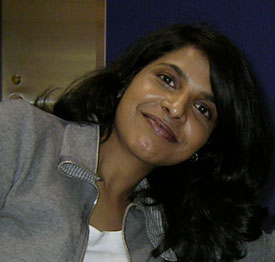Inspiring Students to Solve Math of Planet Earth Problems
By Karthika Swamy Cohen
At the SIAM Conference on Applied Mathematics Education, which was held jointly with the SIAM Annual Meeting in Portland, Ore., last week, Kathleen Kavanagh of Clarkson University gave a minitutorial on successfully involving students—both undergraduates and graduates—in addressing a problem related to the mathematics of planet Earth.
The Pajaro Valley in California produces over 80% of the state’s berries. But the valley has a problem – the aquifer underlying the area is overused, causing seawater infusion. Usage needs to be reduced and groundwater must be recharged or refilled after use.
As far as math problems go, the situation is unique — community members are invested in their land and people are concerned about the aquifer and water pricing. Citizens come together with Driscoll’s strawberry growers to discuss these issues
Math of Planet Earth problems can prepare our future workforce to solve imminent problems.
An American Institute of Mathematics (AIM) workshop on sustainability—with the objective of proposing a mathematical model to address the issue—contacted Kavanagh to spearhead the group.
Kavanagh’s reality was that she had no hard funding for the project. Neither did she have much time as a professor of mathematics at Clarkson University, with many projects up her sleeve.
“But I have amazing students and good connections,” Kavanagh said, looking on the bright side. “I just got tenure and I can work on projects that I really like.”
Kavanagh also has access to additional students working on summer research projects for eight weeks. She explained the issues going on in the valley to her students and asked, “How do we address this mathematically?” Students can pick the level that they want to work at, which is one of the advantages of math modeling.
Driscoll's wanted a farm model to help farmers out — a model that would ask the question “If I plant this much of a crop and rotate it out, how much water am I using? Is there a sustainable solution?” The model would also focus on the best crops to plan to make the land sustainable.
Addressing optimal crop management, recharge/management of surface water, and analysis of floodwater capture and feasibility and impact of catchment basins lend themselves well to mathematical modeling.
Furthermore, real-world problem such as this, along with the incentive of working with real people to come up with a sustainable solution that would help the community, inspires students like no other. Kavanagh was able to work with multiple students over the year, tackling the problem piece by piece.
To give like-minded academicians a sense of how they could pursue similar projects and motivate students to study math at the same time, she went through the list of students and how they contributed to the project
Working with real communities to come up with solutions for a sustainable planet inspires students.
A pre-freshman research student, Jessica Burl, worked on understanding the impact of catchment basins on berry farming in the valley. “What she got out of it was coming straight out of high school research into MATLAB work, learning modeling. She culminated her project with a poster presentation," Kavanagh said.
For his honors thesis, Mark Minick spent his junior and senior years developing a model to track open fields and possible choices for subsequent crops for four years, calculating profit and water use. He obtained his answer with a linear programming model and found a bug in MATLAB along the way! He published a peer-reviewed conference proceeding paper about his work.
A sophomore summer research student, Jayesh Bokhiria, took up the project next. Kavanagh said he expressed interest because his parents own a peanut farm and struggle with what to plant all the time.
He picked up where Minick left off, posing a multi-objective optimization problem assuming that Driscoll's has already optimized demand, and worked to meet sustainable water yield.
Corey Ostrove entered the project at this point, and got a MODFLOW package from the U.S. Geological Survey (USGS) working with a Farm Package. It simulated the consumption and redistribution of surface and ground water for farming. Ostrove ran the farming model and connected it to an optimizer, and obtained a lot of experience with industrial software working on the project.
The next student, Andres Colon—currently a consultant at USGS—was able to make the problem more realistic with dynamic planting (based on weather and related conditions). He learned Python to implement the model.
Kavanagh said that several graduate students have worked on the project over many years as well.
Based on these examples, she made the point that the project is accessible on multiple levels for modeling, simulation, and optimization. Students learned along the way, contributed much to the project, presented posters and talks, and even published peer-reviewed papers.
“The problems drive the mathematics,” Kavanagh said in conclusion. “Earth-related issues motivate problem solving. Students understand the problem, they read about it on the news. They feel they are contributing to make the world a better place. Look around at the university and community and see what you can do.”
 |
Karthika Swamy Cohen is the managing editor of SIAM News.
|